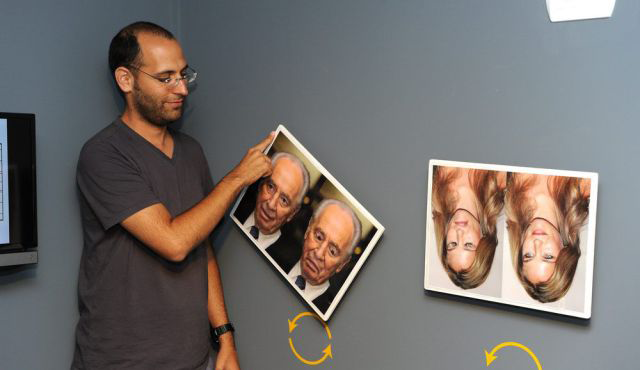
Creating a "monster" at the Garden of Science. Photo by Haim Ziv
These special glasses are just one attraction of many at the Weizmann Institute's Garden of Science.
If you look at an upside-down photograph of the fashion model Bar Refaeli, she looks just fine. When the same picture is turned right-side-up, she suddenly seems monstrous, and you realize that within her upright face, it is the eyes and mouth that have been turned upside down. Because our brain tends to recognize people by their eyes and mouth, we know immediately that this is the same person as long as the eyes and mouth are portrayed right-side-up. Even though they werepositioned in the upside-down face, our brains registered an “all-ok.” There’s a life lesson.
This is only one of the intriguing things about the brain’s operation that you can learn in an interactive exhibition called “Work Your Brain!” at the Weizmann Institute of Science in Rehovot. Provided, of course, that the kids have the patience needed. In our case, it also helped to have a guide – a definitive authority figure – to explain things to the kids as we go along. Our guide was articulate and efficient. He obviously knew the explanations well by heart and threw in a few well-orchestrated questions to the children, along with suggestions for activities. Even if he was a bit pressed for time, the girls obeyed all his instructions and did their best to keep pace.
After he left us to go about his business, I tried to continue the explanations myself, declaiming the wall texts in the same didactic, patient tone. The girls gave me a withering look and immediately shushed me. “Where’s the guide?” Zohar asked irritably.
“That’s the thing. He’s gone. He finished the guiding. Now we can go around on our own and learn things, or go back to things we’ve already seen,” I said in a these-are-the-facts-of-life tone. “You’re not a guide,” Zohar said, and started to walk toward the exit. The only thing that stopped her – though I’d tried to avoid it – was an exhibit of animal brains preserved in jars that were lined up in a row on a wall. Of the animals on display, the fish and the turtle had the smallest brains, the horse had the biggest one. That detail was engraved deeply in the girls’ brains. Seeing isremembering.
While the authority figure was still on hand, we managed to understand that the exhibition is divided into two mainsections. One hall deals with the parts of the brain; how it works and its various functions. The second hall shows 14 studies of the brain that are currently being conducted at the Weizmann Institute. The curators have used a hands-onapproach to make each study accessible to young visitors and give them an idea of its future applications. For example, children can put on eyeglasses thatsimulate the effect of drugs and alcohol on the brain, and they can also encounter colorful genetically engineered fish.
The hall devoted to the parts of the brain and its workings has a mockup MRI machine that can be entered, physical models of the brain for disassembling and reassembling (and also virtual ones – you’ll always get stuck at the Tablets stand), and you can also stand under a network of glittering electric wires that represent the brain’s ramified nerve cells.
Children also enjoy the explanation of how the sense of sight works: There is a small, dark, sealed room – a cameraobscura – through which the outside world is visible with the aid of mirrors and a small opening in the roof. The girls took turns running in and out in order to see each other and guess how manyfingers the one who was outside was holding up. A large inflatable brainlocated at the entrance to the Weizmann Institute’s Garden of Science (the site of the exhibition), which one can enter and hide in, was the major attraction, and the girls spent what seemed like endless time in it.
“Work Your Brain!” is aimed at the 5-and-up age group, and the upper the better, in terms of enjoying and learning from the exhibition. Some of the stands are suffering from overuse and under-maintenance – either not working at all or lacking key elements – such as the stand at which visitors are asked to take part in an experiment related to the sense of smell. The Garden of Science itselfcontains plenty of other entertainingactivities that are not necessarily related to the brain exhibition, such as a large stone xylophone. It is a pleasant place to spend more time after seeing the exhibition.
